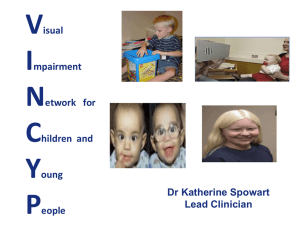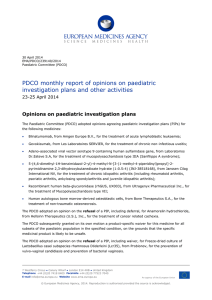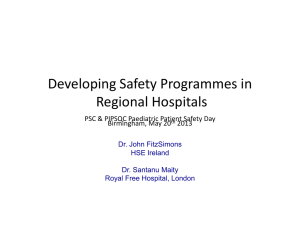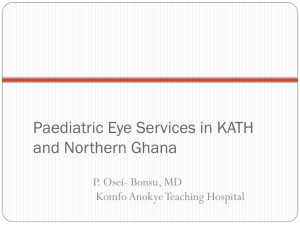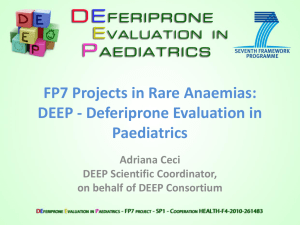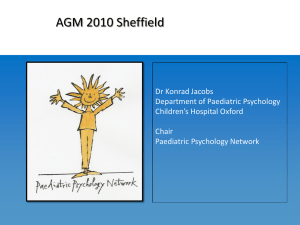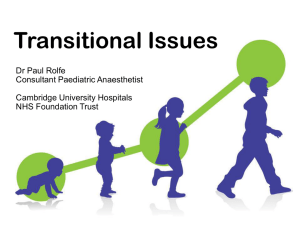Perspectives from a Regulator
advertisement
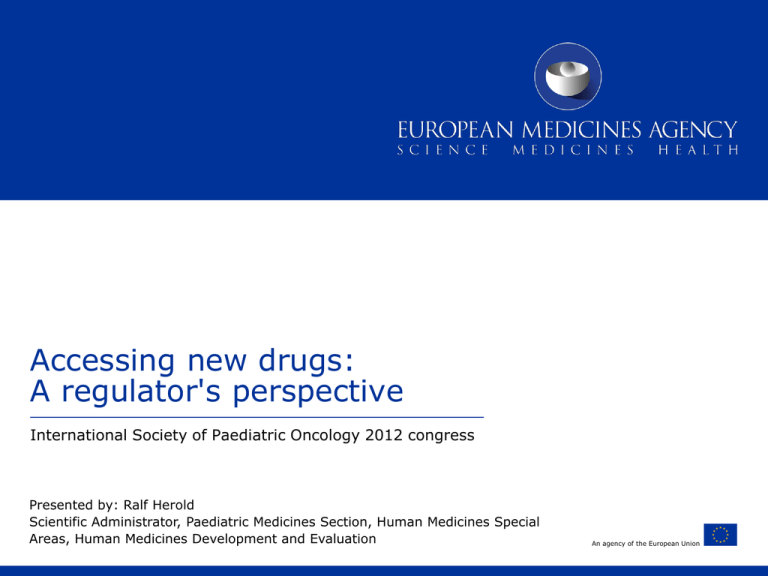
Accessing new drugs: A regulator's perspective International Society of Paediatric Oncology 2012 congress Presented by: Ralf Herold Scientific Administrator, Paediatric Medicines Section, Human Medicines Special Areas, Human Medicines Development and Evaluation An agency of the European Union "Access to new drugs" • Access = To study new drug in non-clinical test and in clinical trial • Scientific steps to accumulate evidence • This is an experiment, not medical care 1 Accessing new drugs - a regulator's perspective • Access = to make sure high-quality medicines are developed and available for authorised use and reimbursement • To advance medical care, which then can be used in clinical trials Regulatory perspective: to safeguard and to improve public health in Europe • Protect population and ensure safety of medicines • European population in its diversity • Neglected subsets in frequent conditions • Respond to global needs • Neglected diseases The choice of the endpoint determines which patient subset is addressed. (after S Hirschfeld) 2 Accessing new drugs - a regulator's perspective DFS PFS TTF OS General tools of regulators to support the development of medicines • Scientific guidelines • Orphan designation (incentives during and after development) • Paediatric investigation plan (incentives) • Needs lists (Paediatric medicines EMA; WHO Essential medicines) • Continuous exchange with other institutions (e.g., ECDC, FDA) • Collaboration with scientific societies • Consultations in public • High level of transparency 3 Accessing new drugs - a regulator's perspective Scientific Committees at the EMA • CHMP, PDCO, CAT, COMP, PRAC • Delegates from the 27 EU Member States + NO + IS • Health professional representatives • Patient organisation representatives • Work to achieve scientific consensus 4 Accessing new drugs - a regulator's perspective Paediatric Regulation (EC) No. 1901/2006 • Relevant for you as medical doctors and investigators • Comprehensive framework of paediatric expertise in EU established: – Paediatric Committee (PeeDeeCeeOh) with EMA secretariat created – European paediatric research network at the EMA (Enpr-EMA) created • Activities and achievements (end 2011*) under Regulation: – PIP / Waiver for all new and (many) authorised medicines mandatory: in total 476 PIP Decisions (33 anti-cancer substances, each 1 or 2 PIPs) – First 43 paediatric indications authorised (1 anti-cancer, more in 2012) – Assessment of completed studies and reports on medicines in children • Difficulties and limitations * http://ec.europa.eu/health/human-use/paediatric-medicines/developments/index_en.htm 5 Accessing new drugs - a regulator's perspective Bevacizumab SmPC: timely update (03/2012), reference to authorised indications, concerns based on results of paediatric trials Paediatric population The safety and efficacy of bevacizumab in children and adolescents have not been established. There is no relevant use of bevacizumab in the paediatric population in the granted indications. Currently available data are described in sections 5.1, 5.2 and 5.3 but no recommendation on a posology can be made. Avastin should not be used in children aged 3 years to less than 18 years with recurrent or progressive high-grade glioma because of efficacy concerns (see 5.1 for results of paediatric trials). Method of administration http://www.ema.europa.eu/docs/en_GB/document_library/EPAR_-_Product_Information/human/000582/WC500029271.pdf The initial dose should be delivered over 90 minutes as an intravenous infusion. If the first infusion is well tolerated, the second infusion may be administered over 60 minutes. If the 60-minute infusion is well tolerated, all subsequent infusions may be administered over 30 minutes. 6 Accessing new drugs - a regulator's perspective Paediatric Investigation Plan agreed by PDCO: the main tool of the Paediatric Regulation • Basis for development and authorisation of a medicine for all paediatric population subsets • PDCO defines paediatric use to be targeted by the study program • Mandatory for new medicinal products under development and for authorised medicines when new indication, route or formulation • Binding on pharmaceutical companies • Completion required once "triggered" in a regulatory submission • Includes studies with details and timing to document quality, safety and efficacy of the medicine 7 Accessing new drugs - a regulator's perspective Regulatory activities in medicine development Phase 1 Phase 2 Phase 3 Regulatory Post-approval Development in adults CHMP PDCO PIP initial submission by applicant to PDCO Non-compliance blocks validation (filing) Scientific Advice 8 Orphan medicine designation Accessing new drugs - a regulator's perspective Procedure for handling applications for agreement of PIP / waiver (SOP/H/3207) Day 30 = First discussion in the PDCO 60 days Day 60 = Second discussion in the PDCO Day 90 = Third discussion in the PDCO Clock stop 60 days Day 120 = Possible oral explanation PDCO Opinion ~ 3 months Day 1 = After validation, Summary report drafted by EMA 9 Day 60 = Adoption “PDCO Request for modification” or “PDCO Opinion” Accessing new drugs - a regulator's perspective Day 61 = Summary report updated with applicant response Day 120 = Adoption “PDCO Opinion” Agreeing / refusing PIP and / or waiver Potentially followed by 30-day Re-examination Difficulties and limitations encountered with implementing the Paediatric Regulation (I) • Assessment of old studies and reports inconclusive: Meaningful paediatric studies difficult to define and conduct • General considerations and areas for improvement – Use of new information by health care professionals uncertain – Variable awareness of need for paediatric clinical research – Paediatric care based on poor evidence infrequently challenged – Some paediatric therapeutic areas have been neglected – Wide-spread off label use not abolished by generating paediatric data 10 Accessing new drugs - a regulator's perspective Activities and responsibilities of regulators and stakeholders Regulating Pharma Company 11 Investi gators Objectives Regulators Accessing new drugs - a regulator's perspective Prescrib ers Difficulties and limitations encountered with implementing the Paediatric Regulation (II) • Difficulties in paediatric oncology: – Regulatory system previously solely based on histopathology – Data not yet available (e.g., biological principle, xenografts, adult studies) to inform which is paediatric malignancy (if any) that could need medicine – Difficulties to build success on mechanism of action and biomarker(s) – Choosing relevant study designs and strategies difficult for all stakeholders – Inefficiencies of setting up and running studies – Inspections of paediatric trials show critical and major findings – Many discussions (e.g., COG, NIH, SIOP) not accessible to EMA – Paediatric trials for oncology medicines ongoing, but no PIP 12 Accessing new drugs - a regulator's perspective Anti-cancer medicines for children: non-clinical and clinical safety findings • Results of first completed juvenile animal studies available – Bone metabolism inhibitor A: effects at all doses, partially reversible, findings have clinical relevance, putative biomarkers found – Tyrosine kinase inhibitor B: no unexpected and no more serious findings compared to clinical profile in adults – Tyrosine kinase inhibitor C: unexpected kidney toxicity (glomerulopathy), generally more serious toxicity compared to clinical profile in adults – Cytotoxic medicine D: no unexpected finding – Pro-apoptotic medicine E: unexpected finding brain hypoplasia 13 Accessing new drugs - a regulator's perspective Anti-cancer medicines for children: difficult discussions of priorities and paediatric interest • Interesting data … • Should blue be a priority? • What is missing? • Full transparency necessary • Data update necessary • Medical data survivors? • Review clinical records? 14 Accessing new drugs - a regulator's perspective Recent activities for paediatric oncology and anti-cancer medicines for children • “Policy on determination of condition for PIP” (EMA/272931/2011) published: criteria for the PDCO to define the paediatric interest based on unmet needs, mode of action, MedDRA or biological criteria • PDCO discusses revoking class waivers, taking into account the evolution of knowledge and science over the last years • Model oncology PIPs in the works to attract pharmaceutical companies, to flag subsets with high unmet needs, to quote priorities • Paediatric oncology task force with experts from community • “Involvement of children and young people at the PDCO” for public consultation (EMA/PDCO/388684/2012 ) • PDCO involved in assessments (CHMP) of paediatric trial results * http://www.ema.europa.eu/ema/index.jsp?curl=pages/regulation/document_listing/document_listing_000293.jsp&mid=WC0b01ac0580025b91 15 Accessing new drugs - a regulator's perspective Summary Regulator's perspective for paediatric oncology: • Oncology PIPs help paediatric oncologists to get medicines for trials and help children with cancer to get safe and efficacious medicines • International scientific exchange collaboration required in view of difficulties in past and present to generate data • Regulators (EMA / PDCO) open to implement collaboration • Need to improve information for high-quality PIPs and priorities 16 Accessing new drugs - a regulator's perspective Acknowledgements • PDCO: Dobrin Konstantinov, Henk van den Berg, Jacqueline Carleer, Janez Jazbec, Jaroslav Sterba, Koenraad Norga, Paolo Paolucci • EMA: Agnès Saint Raymond, Ralph Bax, Francesco Pignatti, Lynley Marshall, Peter Bauer 17 Accessing new drugs - a regulator's perspective

